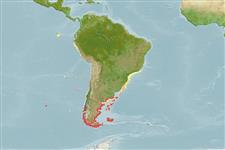Cephalopoda |
Octopoda |
Enteroctopodidae | Octopodinae
Environment: milieu / climate zone / пределы глубины / distribution range
экология
; пределы глубины 5 - 240 m (ссылка 96968). Temperate; 18°S - 58°S, 77°W - 54°W
Southeast Pacific and Southwest Atlantic: Argentina and Chile. Subtropical to temperate.
Length at first maturity / Size / Weight / Возраст
половая зрелость: Lm ? range ? - ? cm Max length : 109 cm TL самец/пол неопределен; (ссылка 83435)
Maximum depth from Ref. 122438.
Life cycle and mating behavior
половая зрелость | размножение | нерест | Eggs | Fecundity | Larvae
Members of the class Cephalopoda are gonochoric. Male and female adults usually die shortly after spawning and brooding, respectively. Mating behavior: Males perform various displays to attract potential females for copulation. During copulation, male grasp the female and inserts the hectocotylus into the female's mantle cavity where fertilization usually occurs. Life cycle: Embryos hatch into planktonic stage and live for some time before they grow larger and take up a benthic existence as adults.
Основная ссылка
ссылки | координатор | соавторы
Bisby, F.A., M.A. Ruggiero, K.L. Wilson, M. Cachuela-Palacio, S.W. Kimani, Y.R. Roskov, A. Soulier-Perkins and J. van Hertum 2005 Species 2000 & ITIS Catalogue of Life: 2005 Annual Checklist. CD-ROM; Species 2000: Reading, U.K. (ссылка 19)
Статус Красного Списка МСОП
(ссылка 130435: Version 2025-1)
Статус СИТЕС (ссылка 108899)
Not Evaluated
CMS (ссылка 116361)
Not Evaluated
Угроза для людей
Использование человеком
рыболовство: коммерческий
| FishSource |
инструменты
дополнительная информация
Trophic EcologyFood items (preys)состав пищипотребление пищихищники Population dynamicsростMax. ages / sizesLength-weight rel.Length-length rel.Размерный составMass conversionчисленность Life cycleразмножениеполовая зрелостьFecundityнерестEggsРазвитие икрыLarvae PhysiologyOxygen consumption
Human RelatedStamps, coins, misc.
ресурсы в Интернет
Estimates based on models
Preferred temperature
(Ref.
115969): 7.3 - 15.9, mean 12.7 (based on 110 cells).
Fishing Vulnerability
High to very high vulnerability (65 of 100).
